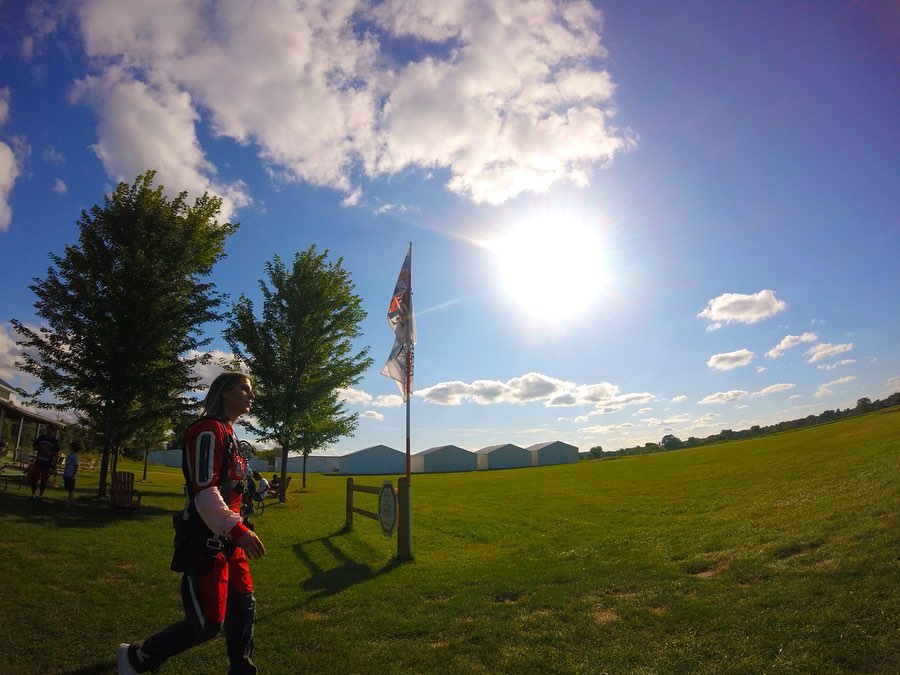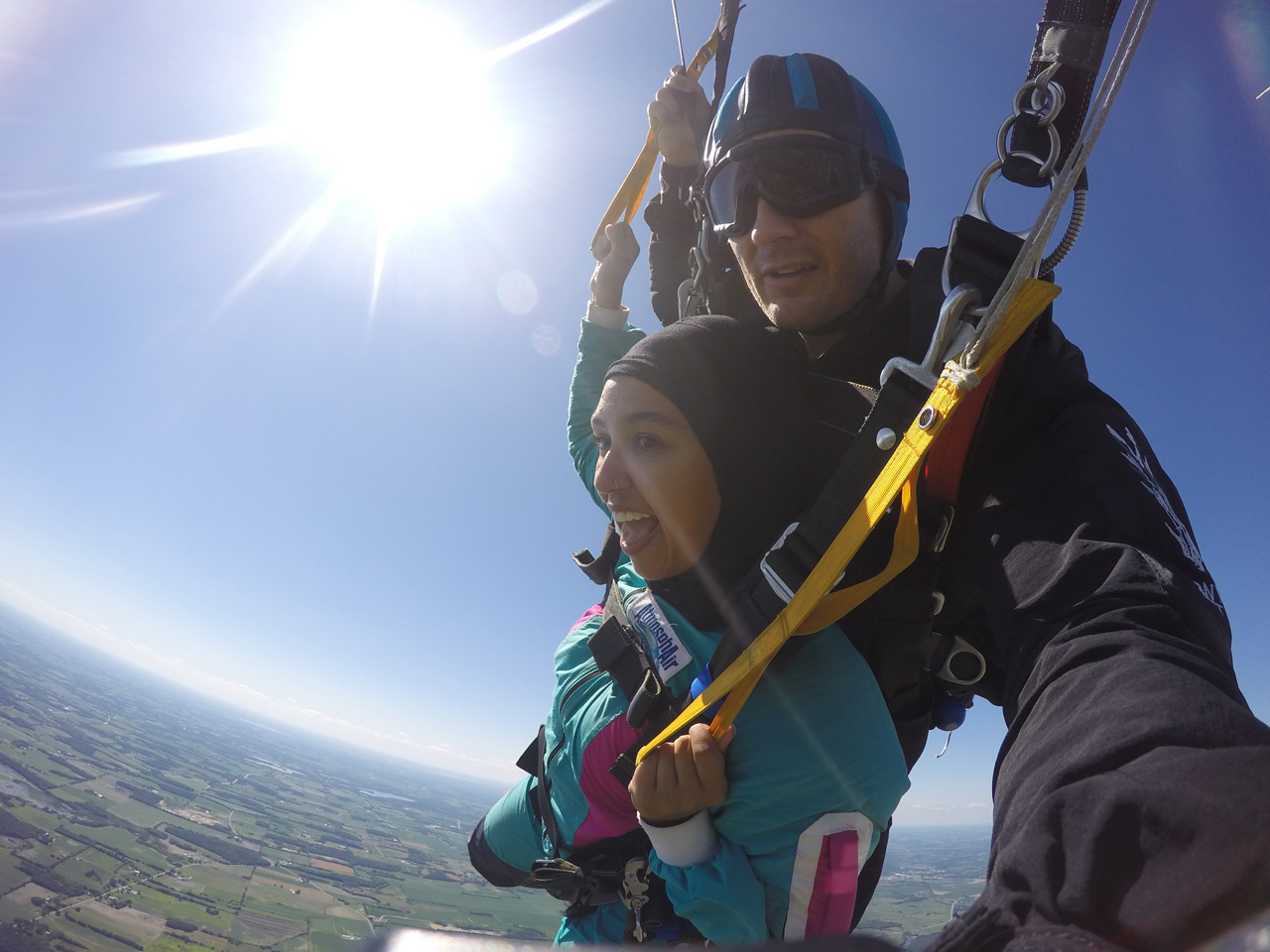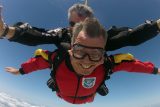Best Weather For Skydiving
Skydiving Safety
Posted by: Wisconsin Skydiving Center 6 days ago
The weather can make or break your skydiving experience. Clear skies, gentle winds, and comfortable temps aren’t just nice to have, they’re essential in the world of skydiving to keep safety at the forefront of our minds. Skydiving is all about minimizing the risks and maximizing the thrill, and we’re able to do that by closely watching the weather. Let’s get into some specifics!
The Best Skydiving Weather: What Matters Most?
What is the best time to go skydiving? Any time you’re able to jump out of an airplane is a good time to skydive! Ha! The best weather for skydiving is a combination of a few conditions: blue skies, calm wind, and enjoyable temperatures.

Blue skies.
Skies with minimal clouds are necessary for safe and epic skydives. Scattered, fluffy clouds floating about add beauty to the sky, but a dense, overcast blanket is a dealbreaker for skydivers. The Federal Aviation Administration (FAA) actually has cloud rules in place for skydivers and their drivers – AKA, the pilots! Why? We need to be able to see where we’re going!
Prior to exiting the airplane, skydivers do something called spotting. This is an act when the jumper intently peers out the door of the open airplane to determine if they’re in a safe location to exit. When spotting, jumpers check for the presence of other aircraft, if they’re in a good location (if they can see where they are meant to land), and if there are any clouds obstructing their view.
Although the safety concern surrounding cloud presence is top priority, they also change the aesthetics of the jump by prohibiting us from optimal views. Experiencing the birdseye view is part of the beauty of the jump!
What about rain? If we aren’t jumping through clouds, we’re definitely not jumping through rain. Skydiving in rain poses extra risk, which is something we’re constantly committed to minimizing.
Calm wind.
Boo, turbulence! What are the best conditions for skydiving when it comes to the wind? Something light and predictable. The risks associated with skydiving are mitigated when we do things with predictability.
For example, every time we land our parachutes, we do so by flying a predictable pattern, which allows other jumpers to feel confident about our next moves. Similarly, wind speed and direction should be predictable. Although skydivers can jump in both high and low winds, we look out for the gusts. If the wind is super gusty, it’s unpredictable in nature, and this is a no-go.
Temperature.
What is the best temperature to skydive in? Sunny and 75? Sure! But there’s a bit of leeway when it comes to the optimal jumping temperature – it just depends on who you are. Some jumpers prefer cooler temps all around, while others live for sweltering summer days and refreshingly cool freefalls.
You’re able to prepare for skydiving temperatures by how much or little clothing you wear. Meaning, it’s possible to jump in chilly temps by bundling up and wearing things like warm underlayers and gloves. Likewise, people can safely jump in hot temps by wearing short sleeves and hanging out in the shade or AC while they’re on the ground. Jumping in temperatures that are way too cold or way too hot can be dangerous, which is why you won’t catch us sending skydives in the depths of winter.

Sweet Summertime: Wisconsin’s Primetime
What season is best for skydiving? Here in Wisconsin, summer skydiving weather offers the best weather conditions for skydiving, but it’s different everywhere. For example, skydiving in the summer in Florida isn’t as optimal as wintertime, but it’s the opposite for us northerners. Our summers offer consistent sunshine, longer daylight hours, and generally stable weather conditions from dawn to dusk. Plus, after you shred the summer skies, you can experience the second-best things the area has to offer, and summertime has the best conditions to do that.
Wondering what to wear skydiving in the summer in Wisconsin? As we increase in altitude, we decrease in temperature, so take that into consideration when choosing your fit for the day. We suggest wearing flexible clothing that you’re comfortable in. We often see short sleeves, pull-overs, leggings, sweatpants, gym shorts, and sneakers (closed-toed shoes are required regardless of the temps).
What If The Weather Is Bad?
Ugh, major, major ‘sigh’ if the weather isn’t conducive for jumping. The weather gods can’t always be in our favor, and if they rain on our parade, we’ll simply help you reschedule your jump to another date. We have to experience the not-so-good days to extra appreciate the great ones! Don’t miss out on soaring through Wisconsin’s perfect summertime skies – book your jump today!
Categories:
You May Be Interested In:

How Many People Die Skydiving Each Year?
6 months ago by Wisconsin Skydiving Center

Can Kids Go Skydiving?
8 months ago by Wisconsin Skydiving Center

How Dangerous Is Skydiving?
10 months ago by Wisconsin Skydiving Center

What’s a Skydiving AAD & Why It Matters
2 years ago by Wisconsin Skydiving Center